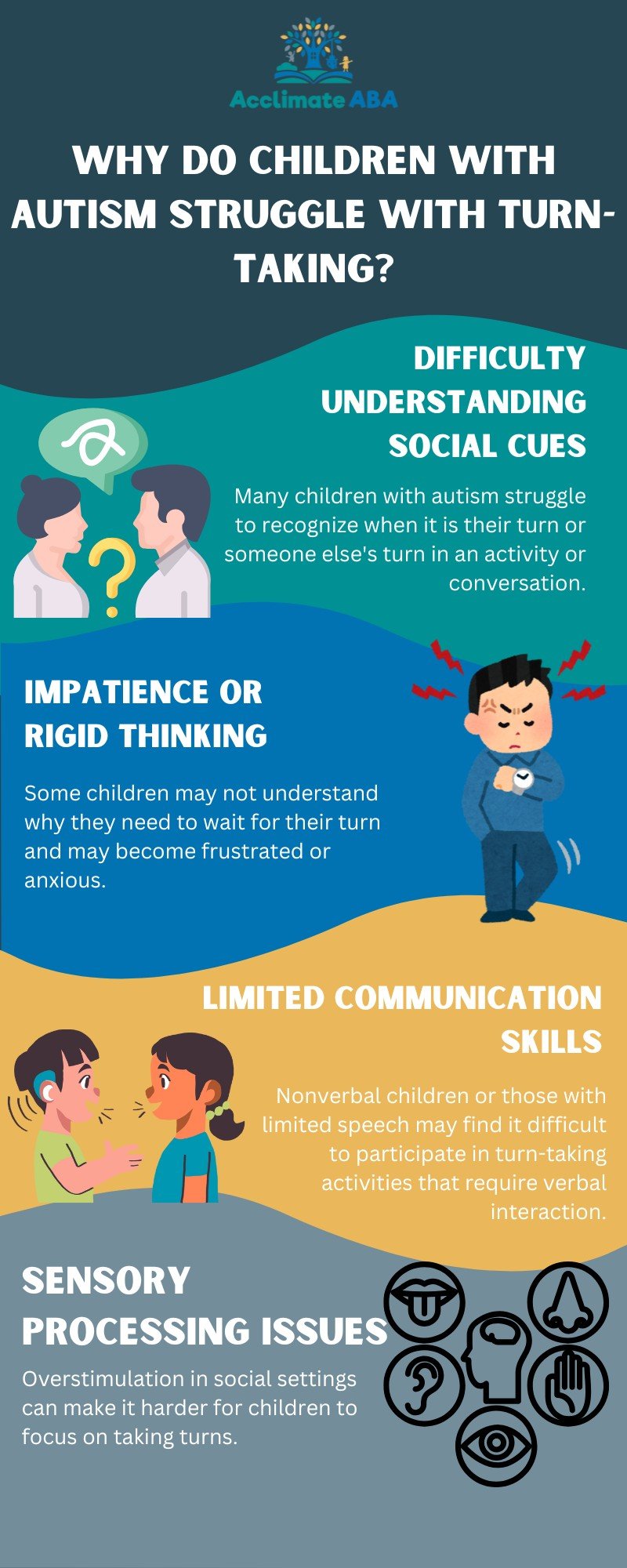How to Teach Turn-Taking to Children with Autism
 Key Points:
Key Points:
- Turn-taking is a critical social skill that many children with autism struggle with due to challenges in communication, flexibility, and social understanding.
- Structured strategies, visual supports, and practice in real-life scenarios help reinforce turn-taking effectively.
- Applied Behavior Analysis (ABA) therapy provides targeted interventions to teach and strengthen turn-taking skills in children with autism.
Taking turns might seem simple, but for children with autism, it’s a big challenge. Whether it’s waiting to speak, sharing a game, or letting others go first, turn-taking requires social awareness and flexibility. Fortunately, with the right strategies, you can help your child practice and master this important life skill.

By identifying these challenges, parents and caregivers can use specific techniques to address their child’s needs.
How You Can Use Structured Activities to Teach Turn-Taking
A structured approach helps children with autism learn turn-taking in a predictable and controlled manner. Begin with simple, engaging activities before progressing to more complex interactions.
1. Use Turn-Taking Games
Start with games that naturally involve turn-taking, such as:
- Rolling a ball back and forth – This introduces the concept of waiting and responding.
- Board games – Simple games like Candy Land or Connect Four reinforce turn-taking in a fun way.
- Musical chairs – Helps children practice waiting and reacting to social cues.
2. Incorporate Visual Supports
Visual aids can clarify expectations for children with autism. Some effective tools include:
- Turn-taking cue cards – Cards with phrases like “My turn” and “Your turn” serve as reminders.
- Visual schedules – Showing the order of turns can reduce anxiety and increase predictability
- Timers or countdowns – A visual timer can help children understand how long they must wait for their turn
3. Model Turn-Taking Behavior
Children learn best by observing. Model turn-taking in everyday situations, such as:
- Taking turns during conversations at home.
- Demonstrating how to wait patiently during activities.
- Praising siblings or peers who display good turn-taking behavior.
Reinforcing Turn-Taking in Real-Life Situations
Once children with autism understand turn-taking in structured settings, applying the skill in everyday life is crucial. Real-world practice helps reinforce their learning and encourages social growth.
Encouraging Turn-Taking in Conversations
Many children with autism struggle to pause and wait in conversations. Teach them to listen, make eye contact, and respond appropriately. Using a visual cue, like a “talking stick,” can help. Practice at home by taking turns during mealtime discussions or bedtime storytelling. Praise your child when they successfully wait and respond, reinforcing positive behavior naturally.
Using Playgroups and Social Activities
Playdates, group games, and shared activities provide real-life opportunities for turn-taking. Choose cooperative games like building with blocks, where each child contributes in order. Supervise and guide interactions to ensure fair turn-taking. Encourage peer models—patient children who can demonstrate waiting their turn and reinforce positive social habits.
Applying Natural Reinforcement
Natural reinforcement helps make turn-taking meaningful. When children wait their turn, they get to continue playing or engaging in enjoyable activities. Encourage turn-taking in daily routines, such as waiting in line or sharing a snack. These moments build patience and reinforce turn-taking as a life skill.
How Can ABA Therapy Help with Turn-Taking
Applied Behavior Analysis (ABA) therapy is highly effective in teaching turn-taking to children with autism. ABA therapists use evidence-based strategies tailored to the child’s specific needs.
1. Breaking Down Turn-Taking into Small Steps
ABA therapy teaches turn-taking by breaking it down into manageable steps. A therapist might:
- Start with nonverbal turn-taking activities, like passing objects.
- Gradually introduce verbal exchanges, such as answering questions.
- Expand to more complex social interactions, like group conversations.
2. Using Reinforcement to Encourage Turn-Taking
ABA therapists use positive reinforcement to encourage turn-taking behaviors. This might include:
- Providing verbal praise or small rewards.
- Using a token system where successful turns earn points toward a reward.
3. Generalizing Turn-Taking Skills to Different Settings
A key goal of ABA therapy is to help children use turn-taking skills across multiple environments. Therapists work with parents and teachers to:
- Practice turn-taking at home and school.
- Adapt strategies to fit different social situations
- Monitor progress and adjust interventions as needed
Looking to deepen your understanding of ABA (Applied Behavior Analysis) therapy and enhance your skills as a parent? Our article, “ABA Parent Training Topics: Key Insights and Best Practices,” offers valuable insights that are crucial for navigating ABA therapy effectively. Whether you’re new to ABA or looking to refine your approach, this guide covers key topics such as reinforcement strategies, behavior management techniques, and how to create a supportive learning environment for your child.
Help Your Child Develop Social Skills with ABA Therapy
Teaching turn-taking to children with autism requires patience, structured activities, and reinforcement. While parents can implement many strategies at home, ABA therapy offers specialized, evidence-based interventions that help children develop turn-taking skills effectively.
At Acclimate ABA, we provide personalized ABA therapy to help children with autism improve their social and communication skills, including turn-taking. Our expert therapists create individualized plans tailored to each child’s needs, ensuring progress in both structured and natural settings.
Contact us today if you’re looking for ABA therapy in Utah and learn how we can support your child’s development. Let’s work together to build essential social skills that will benefit them for a lifetime.
